

Geography and Early Egypt

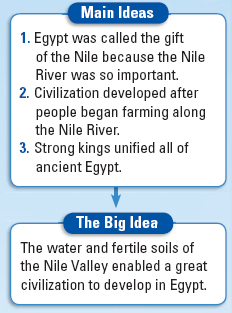
Key Terms

Use the graphic organizer online to take notes on the characteristics of the Nile River and on the way in which it affected Egypt.
If YOU lived there...
Your family farms in the Nile Valley. Each year when the river’s floodwaters spread rich soil on the land, you help your father plant barley. When you are not in the fields, you spin fine linen thread from flax you have grown. Sometimes your family goes on an outing to the river, where your father hunts birds in the tall grasses.
Why do you like living in the Nile Valley?
The Gift of the Nile
Geography played a key role in the development of Egyptian civilization. The Nile River brought life to Egypt and enabled it to thrive. The river was so important to people in this region that the Greek historian Herodotus (hi-RAHD-uh-tuhs) called Egypt the gift of the Nile.
Location and Physical Features
The Nile is the longest river in the world. It begins in central Africa and runs north through Egypt to the Mediterranean Sea, a distance of over 4,000 miles. The civilization of ancient Egypt developed along a 750-mile stretch of the Nile.
Ancient Egypt included two regions, a southern region and a northern region. The southern region was called Upper Egypt. It was so named because it was located upriver in relation to the Nile’s flow. Lower Egypt, the northern region, was located downriver. The Nile sliced through the desert of Upper Egypt. There, it created a fertile river valley about 13 miles wide. On either side of the Nile lay hundreds of miles of bleak desert sands.
As you can see on the map, the Nile flowed through rocky, hilly land to the south of Egypt. At several points, this rough terrain caused cataracts, or rapids, to form. The first cataract was located 720 miles south of the Mediterranean Sea. This cataract, shown by a red bar on the map, marked the southern border of Upper Egypt. Five more cataracts lay farther south. These cataracts made sailing on that portion of the Nile very difficult.
In Lower Egypt, the Nile divided into several branches that fanned out and flowed into the Mediterranean Sea. These branches formed a delta, a triangle-shaped area of land made from soil deposited by a river. At the time of ancient Egypt, swamps and marshes covered much of the Nile Delta. Some two-thirds of Egypt’s fertile farmland was located in the Nile Delta.
The Floods of the Nile
Because little rain fell in the region, most of Egypt was desert. Each year, however, rain fell far to the south of Egypt in the highlands of East Africa. This rainfall caused the Nile River to flood. Almost every year, the Nile flooded Upper Egypt in mid-summer and Lower Egypt in the fall.
The Nile’s flooding coated the land around it with a rich silt. This silt made the soil ideal for farming. The silt also made the land a dark color. That is why Egyptians called their country the black land. They called the dry, lifeless desert beyond the river valley the red land.
Each year, Egyptians eagerly awaited the flooding of the Nile River. For them, the river’s floods were a life-giving miracle. Without the Nile’s regular flooding, people never could have farmed in Egypt. The Nile truly was a gift to Egypt.
 Finding Main Ideas Why was Egypt called the gift of the Nile?
Finding Main Ideas Why was Egypt called the gift of the Nile?
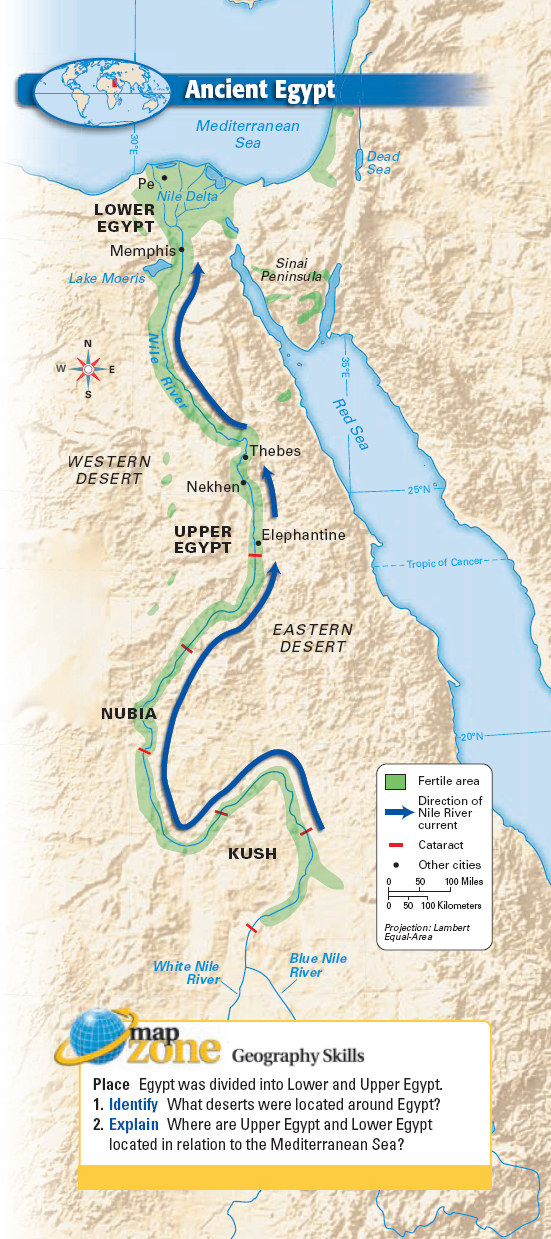
Civilization Develops in Egypt

The Nile provided both water and fertile soil for farming. Over time, scattered farms grew into villages and cities. Eventually, an Egyptian civilization developed.
Increased Food Production
Hunter-gatherers first moved into the Nile Valley more than 12,000 years ago. They found plants, wild animals, and fish there to eat. In time, these people learned how to farm, and they settled along the Nile. By 4500 BC, farmers living in small villages grew wheat and barley.
Over time, farmers in Egypt developed an irrigation system. This system consisted of a series of canals that directed the Nile’s flow and carried water to the fields.
The Nile provided Egyptian farmers with an abundance of food. Farmers in Egypt grew wheat, barley, fruits, and vegetables. They also raised cattle and sheep. The river provided many types of fish, and hunters trapped wild geese and ducks along its banks. With these many sources of food, the Egyptians enjoyed a varied diet.
Two Kingdoms
In addition to a stable food supply, Egypt’s location offered another advantage. It had natural barriers, which made it hard to invade Egypt. To the west, the desert was too big and harsh to cross. To the north, the Mediterranean Sea kept many enemies away. To the east, more desert and the Red Sea provided protection. Finally, to the south, cataracts in the Nile made it difficult for invaders to sail into Egypt that way.

Protected from invaders, the villages of Egypt grew. Wealthy farmers emerged as village leaders. In time, strong leaders gained control over several villages. By 3200 BC, villages had grown and banded together to create two kingdoms—Lower Egypt and Upper Egypt.
Each kingdom had its own capital city where its ruler was based. The capital city of Lower Egypt was Pe, located in the Nile Delta. There, wearing a red crown, the king of Lower Egypt ruled. The capital city of Upper Egypt was Nekhen, located on the Nile’s west bank. In this southern kingdom, the king wore a cone-shaped white crown. For centuries, Egyptians referred to their country as the two lands.
 Summarizing What attracted early settlers to the Nile Valley?
Summarizing What attracted early settlers to the Nile Valley?
Kings Unify Egypt
According to tradition, around 3100 BC Menes (MEE-neez) rose to power in Upper Egypt. Some historians think Menes is a myth and that his accomplishments were really those of other ancient kings named Aha, Scorpion, or Narmer.
Menes wanted to unify the kingdoms of Upper and Lower Egypt. He had his armies invade Lower Egypt and take control of it. Menes then married a princess from Lower Egypt to strengthen his control over the newly unified country.
Menes wore both the white crown of Upper Egypt and the red crown of Lower Egypt to symbolize his leadership over the two kingdoms. Later, he combined the two crowns into a double crown, as you can see on the next page.
Many historians consider Menes to be Egypt’s first pharaoh (FEHR-oh), the title used by the rulers of ancient Egypt. The title pharaoh means “great house.” Menes also founded Egypt’s first dynasty, or series of rulers from the same family.
Menes built a new capital city at the southern tip of the Nile Delta. The city was later named Memphis. It was near where Lower Egypt met Upper Egypt, close to what is now Cairo, Egypt. For centuries, Memphis was the political and cultural center of Egypt. Many government offices were located there, and the city bustled with artistic activity.
Egypt’s First Dynasty was a theocracy that lasted for about 200 years. A theocracy is a government ruled by religious leaders such as priests or a monarch thought to be divine.
Over time, Egypt’s rulers extended Egyptian territory southward along the Nile River and into Southwest Asia. They also improved irrigation and trade, making Egypt wealthier.

Eventually, however, rivals arose to challenge Egypt’s First Dynasty for power. These challengers took over Egypt and established the Second Dynasty. In time, some 30 dynasties would rule ancient Egypt over a span of more than 2,500 years.
 Drawing Inferences Why do you think Menes wanted to rule over both kingdoms of Egypt?
Drawing Inferences Why do you think Menes wanted to rule over both kingdoms of Egypt?
SUMMARY AND PREVIEW As you have read, ancient Egypt began in the fertile Nile River Valley. Two kingdoms developed in this region. The two kingdoms were later united under one ruler, and Egyptian territory grew. In the next section you will learn how Egypt continued to grow and change under later rulers in a period known as the Old Kingdom.

Reviewing Ideas, Terms, and Places
1. a. Identify Where was the Egyptian kingdom of Lower Egypt located?
b. Analyze Why was the delta of the Nile River well suited for settlement?
c. Predict How might the Nile’s cataracts have both helped and hurt Egypt?
2. a. Describe What foods did the Egyptians eat?
b. Analyze What role did the Nile play in supplying Egyptians with the foods they ate?
c. Elaborate How did the desert on both sides of the Nile help ancient Egypt?
3. a. Identify Who was the first pharaoh of Egypt?
b. Draw Conclusions Why did the pharaohs of the First Dynasty wear a double crown?
Critical Thinking
4. Categorizing Create a chart like the one shown here. Use your notes to provide information for each category in the chart.


5. Thinking about Geography and Early History In your riddle, what clues could you include related to Egypt’s geography and early history? For example, you might include the Nile River or pharaohs as clues. Add some ideas to your notes.

The Old Kingdom

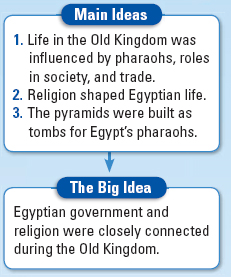
Key Terms

Use the graphic organizer online to take notes on government and religion during Egypt’s Old Kingdom.
If YOU lived there...
You are a farmer in ancient Egypt. To you, the pharaoh is the god Horus as well as your ruler. You depend on his strength and wisdom. For part of the year, you are busy planting crops in your fields. But at other times of the year, you work for the pharaoh. You are helping to build a great tomb so that your pharaoh will be comfortable in the afterlife.
How do you feel about working for the pharaoh?
Life in the Old Kingdom
The First and Second Dynasties ruled ancient Egypt for about four centuries. Around 2700 BC, though, a new dynasty rose to power in Egypt. Called the Third Dynasty, its rule began a period in Egyptian history known as the Old Kingdom.
Early Pharaohs
The Old Kingdom was a period in Egyptian history that lasted for about 500 years, from about 2700 to 2200 BC. During this time, the Egyptians continued to develop their political system. The system they developed was based on the belief that Egypt’s pharaoh, or ruler, was both a king and a god.
The ancient Egyptians believed that Egypt belonged to the gods. The Egyptians believed the pharaoh had come to Earth in order to manage Egypt for the rest of the gods. As a result, he had absolute power over all the land and people in Egypt.
But the pharaoh’s status as both king and god came with many responsibilities. People blamed him if crops did not grow well or if disease struck. They also demanded that the pharaoh make trade profitable and prevent wars.


The most famous pharaoh of the Old Kingdom was Khufu (KOO-foo), who ruled in the 2500s BC. Even though he is famous, we know relatively little about Khufu’s life. Egyptian legend says that he was cruel, but historical records tell us that the people who worked for him were well fed. Khufu is best known for the monuments that were built to him.
Society and Trade
By the end of the Old Kingdom, Egypt had about 2 million people. As the population grew, social classes appeared. The Egyptians believed that a well-ordered society would keep their kingdom strong.
At the top of Egyptian society was the pharaoh. Just below him were the upper classes, which included priests and key government officials. Many of these priests and officials were nobles, or people from rich and powerful families.
Next in society was the middle class. This class included lesser government officials, scribes, and a few rich craftspeople.
The people in Egypt’s lower class, more than 80 percent of the population, were mostly farmers. During flood season, when they could not work in the fields, farmers worked on the pharaoh’s building projects. Servants and slaves also worked hard.
As society developed during the Old Kingdom, Egypt traded with some of its neighbors. Traders traveled south along the Nile to Nubia to acquire gold, copper, ivory, slaves, and stone for building. Trade with Syria provided Egypt with wood for building and for fire.
Egyptian society grew more complex during this time. It continued to be organized, disciplined, and highly religious.
 Generalizing How was society structured in the Old Kingdom?
Generalizing How was society structured in the Old Kingdom?
Religion and Egyptian Life
Worshipping the gods was a part of daily life in Egypt. But the Egyptian focus on religion extended beyond people’s lives. Many customs focused on what happened after people died.
The Gods of Egypt
The Egyptians practiced polytheism. Before the First Dynasty, each village worshipped its own gods. During the Old Kingdom, however, Egyptian officials expected everyone to worship the same gods, though how people worshipped the gods might differ from place to place.
The Egyptians built temples to the gods all over the kingdom. Temples collected payments from both worshippers and the government. These payments enabled the temples to grow more influential.
Over time, certain cities became centers for the worship of certain gods. In the city of Memphis, for example, people prayed to Ptah, the creator of the world.
The Egyptians worshipped many gods besides Ptah. They had gods for nearly everything, including the sun, the sky, and Earth. Many gods blended human and animal forms. For example, Anubis, the god of the dead, had a human body but a jackal’s head. Other major gods included
• Re, or Amon-Re, the sun god
• Osiris, the god of the underworld
• Isis, the goddess of magic
• Horus, a sky god; god of the pharaohs
• Thoth, the god of wisdom
• Geb, the Earth god
Egyptian families also worshipped household gods at shrines in their homes.



Emphasis on the Afterlife
Much of Egyptian religion focused on the afterlife, or life after death. The Egyptians believed that the afterlife was a happy place. Paintings from Egyptian tombs show the afterlife as an ideal world where all the people are young and healthy.
The Egyptian belief in the afterlife stemmed from their idea of ka (KAH), or a person’s life force. When a person died, his or her ka left the body and became a spirit. The ka remained linked to the body and could not leave its burial site. However, it had all the same needs that the person had when he or she was living. It needed to eat, sleep, and be entertained.
To fulfill the ka’s needs, people filled tombs with objects for the afterlife. These objects included furniture, clothing, tools, jewelry, and weapons. Relatives of the dead were expected to bring food and beverages to their loved ones’ tombs so the ka would not be hungry or thirsty.
Burial Practices
Egyptian ideas about the afterlife shaped their burial practices. For example, the Egyptians believed that a body had to be prepared for the afterlife before it could be placed in a tomb. This meant the body had to be preserved. If the body decayed, its spirit could not recognize it. That would break the link between the body and spirit. The ka would then be unable to receive the food and drink it needed.
To help the ka, Egyptians developed a method called embalming to preserve bodies and to keep them from decaying. Egyptians preserved bodies as mummies, specially treated bodies wrapped in cloth. Embalming preserves a body for many, many years. A body that was not embalmed decayed far more quickly.
Embalming was a complex process that took several weeks to complete. In the first step, embalmers cut open the body and removed all organs except for the heart. Embalmers stored the removed organs in special jars. Next, the embalmers used a special substance to dry out the body. They later applied some special oils. The embalmers then wrapped the dried-out body with linen cloths and bandages, often placing special charms inside the cloth wrappings.
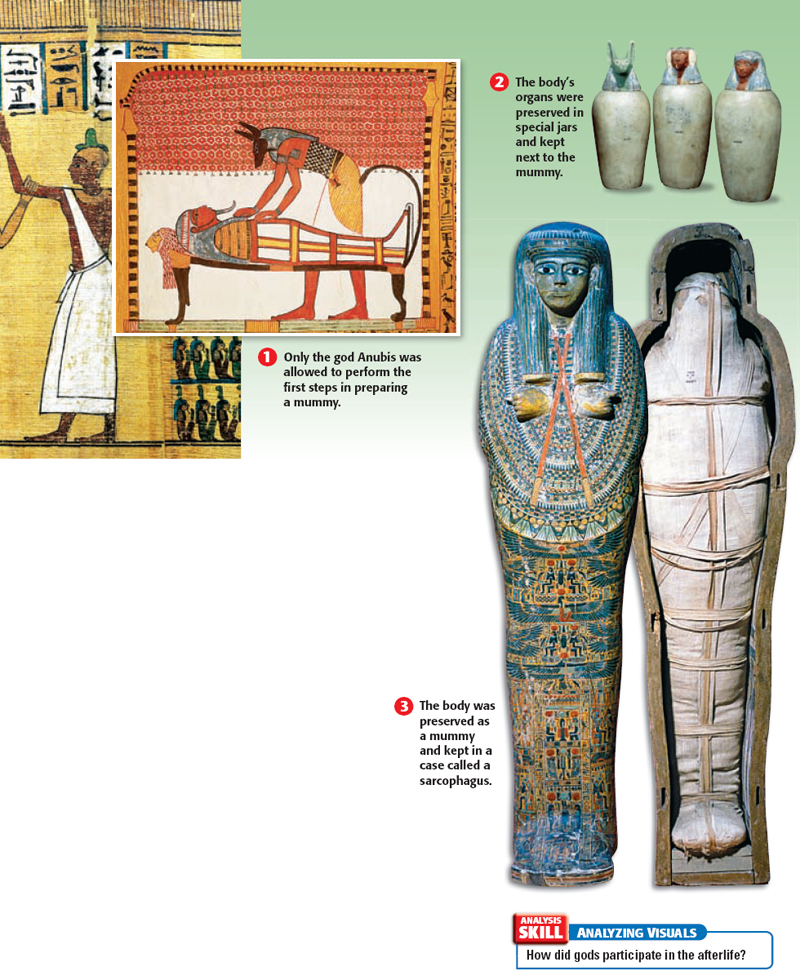
Wrapping the body was the last step in the mummy-making process. Once it was completely wrapped, a mummy was placed in a coffin called a sarcophagus, such as the one shown at right.
Only royalty and other members of Egypt’s elite (AY -leet), or people of wealth and power, could afford to have mummies made. Peasant families did not need the process. They buried their dead in shallow graves at the edge of the desert. The hot, dry sand preserved the bodies naturally.
 Analyzing How did religious beliefs affect Egyptian burial practices?
Analyzing How did religious beliefs affect Egyptian burial practices?

The Pyramids
The Egyptians believed that burial sites, especially royal tombs, were very important. For this reason, they built spectacular monuments in which to bury their rulers. The most spectacular were the pyramids —huge, stone tombs with four triangle-shaped sides that met in a point on top.
The Egyptians built the first pyramids during the Old Kingdom. Some of the largest pyramids were built during that time. Many of these huge Egyptian pyramids are still standing. The largest is the Great Pyramid of Khufu near the town of Giza. It covers more than 13 acres at its base and stands 481 feet (146 m) high. This one pyramid took thousands of workers and more than 2 million limestone blocks to build. Like all the pyramids, it is an amazing example of Egyptian engineering , the application of scientific knowledge for practical purposes.

Building the Pyramids
The earliest pyramids did not have the smooth sides we usually imagine when we think of pyramids. The Egyptians began building the smooth-sided pyramids we usually see around 2700 BC. The steps of these pyramids were filled and covered with limestone. The burial chamber was located deep inside the pyramid. After the pharaoh’s burial, workers sealed the passages to this room with large blocks.
Historians do not know for certain how the ancient Egyptians built the pyramids. What is certain is that such massive projects required a huge labor force. As many as 100,000 workers may have been needed to build just one pyramid. The government paid the people working on the pyramids. Wages for working on construction projects were paid in goods such as grain instead of money, however.

For years, scholars have debated how the Egyptians moved the massive stones used to build the pyramids. Some scholars think that during the Nile’s flooding, builders floated the stones downstream directly to the construction site. Most historians believe that workers used brick ramps and strong wooden sleds to drag the stones up the pyramid once at the building site.
Significance of the Pyramids
Burial in a pyramid showed a pharaoh’s importance. Both the size and shape of the pyramid were symbolic. Pointing to the sky above, the pyramid symbolized the pharaoh’s journey to the afterlife. The Egyptians wanted the pyramids to be spectacular because they believed the pharaoh, as their link to the gods, controlled everyone’s afterlife. Making the pharaoh’s spirit happy was a way of ensuring happiness in one’s own afterlife.
To ensure that the pharaohs remained safe after death, the Egyptians sometimes wrote magical spells and hymns on tombs. Together, these spells and hymns are called Pyramid Texts. The first such text, addressed to Re, the sun god, was carved into the pyramid of King Unas (OO-nuhs). He was a pharaoh of the Old Kingdom.
“Re, this Unas comes to you, A spirit indestructible . . . Your son comes to you, this Unas . . . May you cross the sky united in the dark, May you rise in lightland, [where] you shine!”
–from Pyramid Text, Utterance 217
The builders of Unas’s pyramid wanted the god Re to look after their leader’s spirit. Even after death, the Egyptians’ pharaoh was important to them.
 Identifying Points of View Why were pyramids important to the ancient Egyptians?
Identifying Points of View Why were pyramids important to the ancient Egyptians?
SUMMARY AND PREVIEW As you have read, during the Old Kingdom, new political and social orders were created in Egypt. Religion was important, and many pyramids were built for pharaohs. In the next section you will learn about Egypt’s Middle and New Kingdoms.

Reviewing Ideas, Terms, and Places
1. a. Define To what Egyptian period does the phrase Old Kingdom refer?
b. Analyze Why did Egyptians never question the pharaoh’s authority?
c. Elaborate Why do you think pharaohs might have wanted the support of nobles?
2. a. Define What did Egyptians mean by the afterlife?
b. Analyze Why was embalming important to Egyptians?
3. a. Describe What is engineering?
b. Elaborate What does the building of the pyramids tell us about Egyptian society?
Critical Thinking
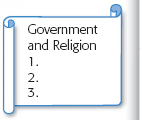
4. Generalizing Using your notes, complete this graphic organizer by listing three facts about the relationship between government and religion in the Old Kingdom.

5. Noting Characteristics of the Old Kingdom The Old Kingdom has special characteristics of government, society, and religion. Write down details about any of those characteristics that you might want to include as one of the clues in your Egypt riddle.

The Middle and New Kingdoms

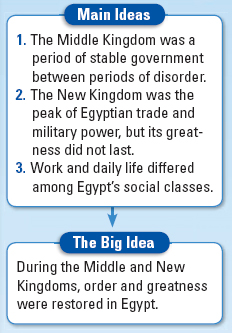
Key Terms

Use the graphic organizer online to take notes on the Middle and New Kingdoms and on work and life in ancient Egypt.
If YOU lived there...
You are a servant to Hatshepsut, the ruler of Egypt. You admire her, but some people think a woman should not rule. She calls herself king and dresses like a pharaoh—even wearing a fake beard. That was your idea! But you want to help more.
What could Hatshepsut do to show her authority?
The Middle Kingdom
At the end of the Old Kingdom, the wealth and power of the pharaohs declined. Building and maintaining pyramids cost a lot of money. Pharaohs could not collect enough taxes to keep up with their expenses. At the same time, ambitious nobles used their government positions to take power from pharaohs.
In time, nobles gained enough power to challenge Egypt’s pharaohs. By about 2200 BC the Old Kingdom had fallen. For the next 160 years, local nobles ruled much of Egypt. During this period, the kingdom had no central ruler.


Finally, around 2050 BC, a powerful pharaoh defeated his rivals. Once again all of Egypt was united. His rule began the Middle Kingdom, a period of order and stability that lasted to about 1750 BC. Toward the end of the Middle Kingdom, however, Egypt began to fall into disorder once again.
Around 1750 BC, a group from Southwest Asia called the Hyksos (HIK-sohs) invaded. The Hyksos used horses, chariots, and advanced weapons to conquer Lower Egypt. The Hyksos then ruled the region as pharaohs for 200 years.
The Egyptians eventually fought back. In the mid-1500s BC, Ahmose (AHM-ohs) of Thebes declared himself king and drove the Hyksos out of Egypt. Ahmose then ruled all of Egypt.
 Summarizing What caused the end of the Middle Kingdom?
Summarizing What caused the end of the Middle Kingdom?

The New Kingdom
Ahmose’s rise to power marked the start of Egypt’s eighteenth dynasty. More importantly, it was the start of the New Kingdom, the period during which Egypt reached the height of its power and glory. During the New Kingdom, which lasted from about 1550 to 1050 BC, conquest and trade brought wealth to the pharaohs.
Building an Empire
After battling the Hyksos, Egypt’s leaders feared future invasions. To prevent such invasions from occurring, they decided to take control of all possible invasion routes into the kingdom. In the process, these leaders turned Egypt into an empire.
Egypt’s first target was the homeland of the Hyksos. After taking over that area, the army continued north and conquered Syria. As you can see from the map, Egypt took over the entire eastern shore of the Mediterranean and the kingdom of Kush, south of Egypt. By the 1400s BC, Egypt was the leading military power in the region. Its empire extended from the Euphrates River to southern Nubia.
Military conquests made Egypt rich as well as powerful. The kingdoms that Egypt conquered regularly sent gifts and treasure to their Egyptian conquerors. For example, the kingdom of Kush in Nubia sent yearly payments of gold, precious stones, and leopard skins to the pharaohs. In addition, Assyrian, Babylonian, and Hittite kings sent expensive gifts to Egypt in an effort to maintain good relations.
Growth and Effects of Trade
As Egypt’s empire expanded, so did its trade. Conquest brought Egyptian traders into contact with more distant lands. Many of these lands had valuable resources for trade. The Sinai Peninsula is one example. It had valuable supplies of turquoise and copper. Profitable trade routes, or paths followed by traders, developed from Egypt to these lands, as the map shows.
One of Egypt’s rulers who worked to increase trade was Queen Hatshepsut . She sent Egyptian traders south to trade with the kingdom of Punt on the Red Sea and north to trade with people in Asia Minor and Greece.
Hatshepsut and later pharaohs used the money they gained from trade to support the arts and architecture. Hatshepsut in particular is remembered for the many impressive monuments and temples built during her reign. The best known of these structures was a magnificent temple built for her near the city of Thebes.
Invasions of Egypt
Despite its military might, Egypt still faced threats to its power. In the 1200s BC the pharaoh Ramses (RAM-seez) II, or Ramses the Great , fought the Hittites, who came from Asia Minor. The two powers fought fiercely for years, but neither one could defeat the other.
Egypt faced threats in other parts of its empire as well. To the west, a people known as the Tehenu invaded the Nile Delta. Ramses fought them off and built a series of forts to strengthen the western frontier. This proved to be a wise decision because the Tehenu invaded again a century later. Faced with Egypt’s strengthened defenses, the Tehenu were defeated once again.
Soon after Ramses the Great died, invaders called the Sea Peoples sailed into Southwest Asia. Little is known about these people. Historians are not even sure who they were. All we know is that they were strong warriors who had crushed the Hittites and destroyed cities in Southwest Asia. Only after 50 years of fighting were the Egyptians able to turn them back.
Egypt survived, but its empire in Asia was gone. Shortly after the invasions of the Hittites and the Sea Peoples, the New Kingdom came to an end. Ancient Egypt fell into a period of violence and disorder. Egypt would never regain its power.
 Identifying Cause and Effect What caused Egypt’s growth of trade during the New Kingdom?
Identifying Cause and Effect What caused Egypt’s growth of trade during the New Kingdom?
Work and Daily Life
Although Egyptian dynasties rose and fell, daily life for Egyptians did not change very much. But as the population grew, Egypt’s society became even more complex.
A complex society requires people to take on different jobs. In Egypt, these jobs were often passed on within families. At a young age, boys started to learn their future jobs from their fathers.
Scribes
After the priests and government officials, scribes were the most respected people in ancient Egypt. As members of the middle class, scribes worked for the government and the temples. This work involved keeping records and accounts. Scribes also wrote and copied religious and literary texts. Because of their respected position, scribes did not have to pay taxes. For this reason, many scribes became wealthy.

Artisans, Artists, and Architects
Another group in society was made up of artisans whose jobs required advanced skills. Among the artisans who worked in Egypt were sculptors, builders, carpenters, jewelers, metalworkers, and leatherworkers. Artisans made items such as statues, furniture, jewelry, pottery, and shoes. Most artisans worked for the government or for temples. Egypt’s artisans were admired and often paid fairly well.
Architects and artists were admired in Egypt as well. Architects designed the temples and royal tombs for which Egypt is famous. Talented architects could rise to become high government officials. Artists often worked for the state or for temples. Egyptian artists produced many different types of works. Many artists worked in the deep burial chambers of the pharaohs’ tombs painting detailed pictures.
Merchants and Traders
Although trade was important to Egypt, only a small group of Egyptians became merchants and traders. Some traveled long distances to buy and sell goods. On their journeys, merchants were usually accompanied by soldiers, scribes, and laborers.
Soldiers
After the wars of the Middle Kingdom, Egypt established a professional army. The military offered people a chance to rise in social status. Soldiers received land as payment and could also keep any treasure they captured in war. Soldiers who excelled could be promoted to officer positions.
Farmers and Other Peasants
As in the society of the Old Kingdom, Egyptian farmers and other peasants were toward the bottom of Egypt’s social scale. These hardworking people made up the vast majority of Egypt’s population.
Egyptian farmers grew crops to support their families. These farmers depended on the Nile’s regular floods to grow their crops. Farmers used wooden hoes or plows pulled by cows to prepare the land before the flood. After the floodwaters had drained away, farmers planted seeds for crops such as wheat and barley. At the end of the growing season, Egypt’s farmers worked together to gather the harvest.
Farmers had to give some of their crops to the pharaoh as taxes. These taxes were intended to pay the pharaoh for use of the land. Under Egyptian law, the pharaoh controlled all land in the kingdom.
All peasants, including farmers, were also subject to special duty. Under Egyptian law, the pharaoh could demand at any time that people work on projects, such as building pyramids, mining gold, or fighting in the army. The government paid the workers in grain.
Slaves
The few slaves in Egyptian society were considered lower than farmers. Many slaves were convicted criminals or prisoners captured in war. These slaves worked on farms, on building projects, in workshops, and in private households. Unlike most slaves in history, however, slaves in Egypt had some legal rights. Also, in some cases, they could earn their freedom.
Family Life in Egypt
Family life was very important in Egyptian society. Most Egyptian families lived in their own homes. Sometimes unmarried female relatives lived with them, but men were expected to marry young so that they could start having children.
Most Egyptian women were devoted to their homes and families. Some women, however, did have jobs outside the home. A few women served as priestesses, and some worked as royal officials, administrators, or artisans. Unlike most women in ancient times, Egyptian women had a number of legal rights. They could own property, make contracts, and divorce their husbands. They could even keep their property after a divorce.
Children’s lives were not as structured as adults’ lives were. Children played with toys such as dolls, tops, and clay animal figurines. Children also played ballgames and hunted. Most children, boys and girls, received some education. At school they learned morals, writing, math, and sports. At age 14 most boys left school to enter their father’s profession. At that time, they took their place in Egypt’s social structure.
 Categorizing What types of jobs existed in ancient Egypt?
Categorizing What types of jobs existed in ancient Egypt?
SUMMARY AND PREVIEW Pharaohs faced many challenges to their rule. After the defeat of the Hyksos, Egypt grew in land and wealth. People in Egypt worked at many jobs. In the next section you will learn about Egyptian achievements.

Reviewing Ideas, Terms, and Places
1. a. Define What was the Middle Kingdom?
b. Analyze How did Ahmose manage to become king of all Egypt?
2. a. Recall What two things brought wealth to the pharaohs during the New Kingdom?
b. Explain What did Hatshepsut do as pharaoh of Egypt?
3. a. Identify What job employed the majority of the people in Egypt?
b. Analyze What rights did Egyptian women have?
c. Elaborate Why do you think scribes were so honored in Egyptian society?
Critical Thinking

4. Categorizing Draw pyramids like the ones shown. Using your notes, fill in the pyramids with the political and military factors that led to the rise and fall of the Middle and New Kingdoms.

5. Developing Ideas from the Middle and New Kingdoms Your riddle should contain information about these periods. Decide which key ideas you should include and add them to your list.

Ramses the Great
How could a ruler achieve fame that would last 3,000 years?
When did he live? late 1300s and early 1200s BC
Where did he live? As pharaoh, Ramses lived in a city he built on the Nile Delta. The city's name, Pi-Ramesse, means the “house of Ramses.” This copy of an ancient painting shows Ramses the Great on his chariot in battle against the Hittites.
What did he do? From a young age, Ramses was trained as a ruler and a fighter. Made an army captain at age 10, he began military campaigns even before he became pharaoh. During his reign, Ramses greatly increased the size of his kingdom.
Why is he important? Many people consider Ramses the last great Egyptian pharaoh. He accomplished great things, but the pharaohs who followed could not maintain them. Both a great warrior and a great builder, he is known largely for the massive monuments he built. The temples at Karnak, Luxor, and Abu Simbel stand as 3,000-yearold symbols of the great pharaoh's power.
Drawing Conclusions Why do you think Ramses built monuments all over Egypt?
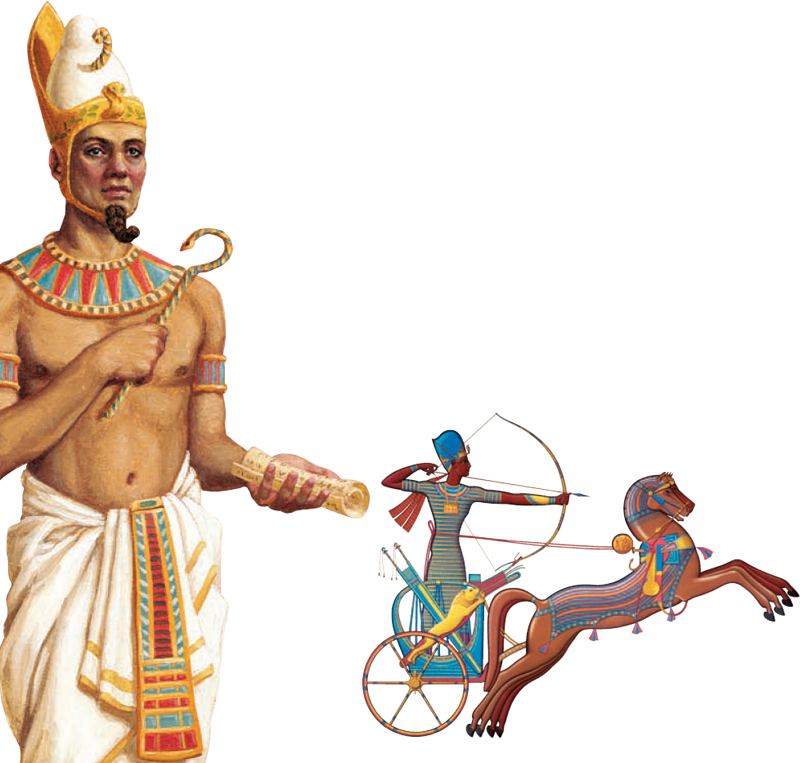
KEY IDEAS
Ramses had a poem praising him carved into the walls of five temples, including Karnak. One verse of the poem praises Ramses as a great warrior and the defender of Egypt.
“Gracious lord and bravest king, savior-guard
Of Egypt in the battle, be our ward;
Behold we stand alone, in the hostile Hittite ring,
Save for us the breath of life,
Give deliverance from the strife,
Oh! protect us Ramses Miamun!
Oh! save us, mighty king!”
–Pen-ta-ur, quoted in The World's Story, edited by Eva March Tappan
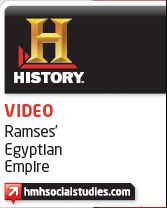

Egyptian Achievements


Key Terms

Use the graphic organizer online to take notes on the achievements of the ancient Egyptians.
If YOU lived there...
You are an artist in ancient Egypt. A powerful noble has hired you to decorate the walls of his family tomb. You are standing inside the new tomb, studying the bare, stone walls that you will decorate. No light reaches this chamber, but your servant holds a lantern high. You’ve met the noble only briefly but think that he is someone who loves his family, the gods, and Egypt.
What will you include in your painting?
Egyptian Writing
If you were reading a book and saw pictures of folded cloth, a leg, a star, a bird, and a man holding a stick, would you know what it meant? You would if you were an ancient Egyptian. In the Egyptian writing system, or hieroglyphics (hy-ruh-GLIH-fiks), those five symbols together meant “to teach.” Egyptian hieroglyphics were one of the world’s first writing systems.
Writing in Ancient Egypt
The earliest known examples of Egyptian writing are from around 3300 BC. These early Egyptian writings were carved in stone or on other hard materials. Later, Egyptians learned how to make papyrus (puh-PY -ruhs), a long-lasting, paperlike material made from reeds. The Egyptians made papyrus by pressing layers of reeds together and pounding them into sheets. These sheets were tough and durable, yet could be rolled into scrolls. Scribes wrote on papyrus using brushes and ink.

The hieroglyphic writing system used more than 600 symbols, mostly pictures of objects. Each symbol represented one or more sounds in the Egyptian language. For example, a picture of an owl represented the same sound as our letter M.
Hieroglyphics could be written either horizontally or vertically. They could be written from right to left or from left to right. These options made hieroglyphics flexible to write but difficult to read. The only way to tell which way a text is written is to look at individual symbols.
The Rosetta Stone
Historians and archaeologists have known about hieroglyphics for centuries. For a long time, though, historians did not know how to read them. In fact, it was not until 1799 that a lucky discovery by a French soldier gave historians the key they needed to read ancient Egyptian writing.
That key was the Rosetta Stone, a huge, stone slab inscribed with hieroglyphics. In addition to the hieroglyphics, the Rosetta Stone had text in Greek and a later form of Egyptian. Because the message in all three languages was the same, scholars who knew Greek were able to figure out what the hieroglyphics said.
Egyptian Texts
Because papyrus did not decay in Egypt’s dry climate, many ancient Egyptian texts still survive. These texts include government records, historical records, science texts, and medical manuals. In addition, many literary works have survived. Some of them, such as The Book of the Dead, tell about the afterlife. Others tell stories about gods and kings.
 Comparing How is our writing system similar to hieroglyphics?
Comparing How is our writing system similar to hieroglyphics?
Egypt’s Great Temples
In addition to their writing system, the ancient Egyptians are famous for their magnificent architecture. You have already read about the Egyptians’ most famous structures, the pyramids. But the Egyptians also built massive temples. Those that survive are among the most spectacular sites in Egypt today.
The Egyptians believed that temples were the homes of the gods. People visited the temples to worship, offer the gods gifts, and ask for favors.
Many Egyptian temples shared some similar features. Rows of stone sphinxes–imaginary creatures with the bodies of lions and the heads of other animals or humans–lined the path leading to the entrance. That entrance itself was a huge, thick gate. On either side of the gate might stand an obelisk (AH-buh-lisk ), a tall, four-sided pillar that is pointed on top.
Inside, Egyptian temples were lavishly decorated, as you can see in the drawing of the Temple of Karnak. Huge columns supported the temple’s roof. These columns were often covered with paintings and hieroglyphics, as were the temple walls. Statues of gods and pharaohs often stood along the walls as well. The sanctuary, the most sacred part of the building, was at the far end of the temple.
The Temple of Karnak is only one of Egypt’s great temples. Other temples were built by Ramses the Great at Abu Simbel and Luxor. The temple at Abu Simbel is especially known for the huge statues that stand next to its entrance. The 66-foot-tall statues are carved out of sandstone cliffs and show Ramses the Great as pharaoh. Nearby are smaller statues of his family.
 Generalizing What were some features of ancient Egyptian temples?
Generalizing What were some features of ancient Egyptian temples?
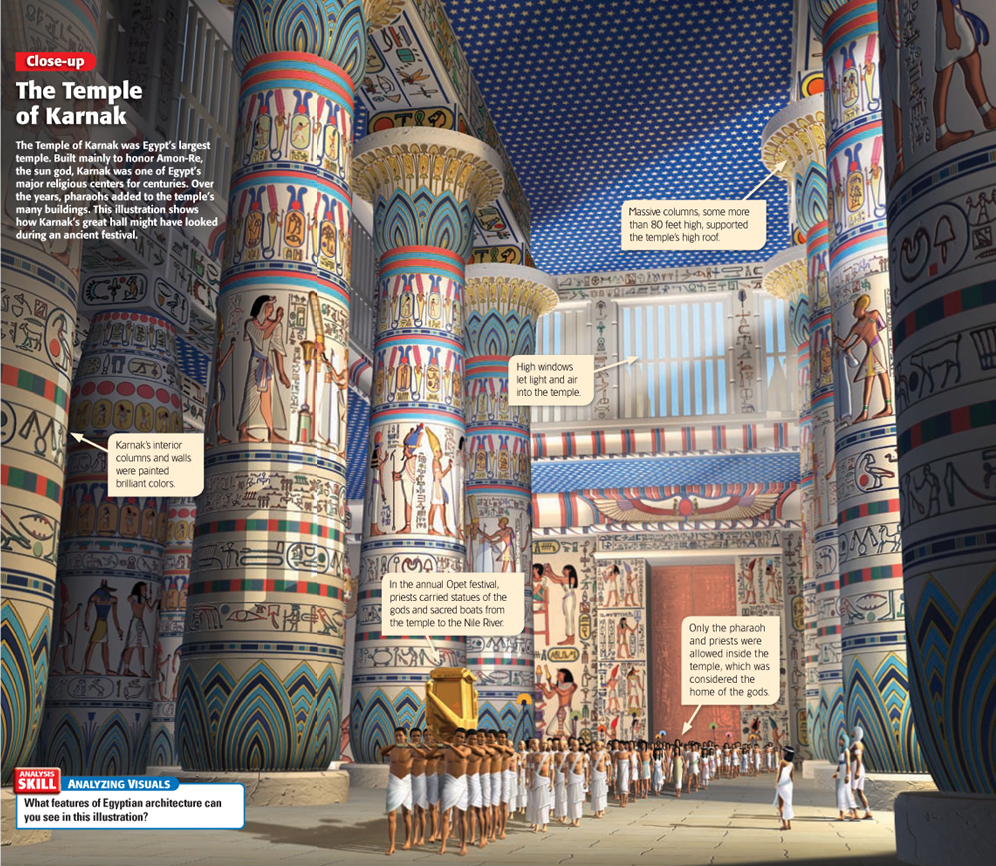

Egyptian Art
One reason Egypt’s temples are so popular with tourists is the art they contain. The ancient Egyptians were masterful artists. Many of their greatest works were created to fill the tombs of pharaohs and other nobles. The Egyptians took great care in making these items because they believed the dead could enjoy them in the afterlife.
Paintings
Egyptian art was filled with lively, colorful scenes. Detailed works covered the walls of temples and tombs. Artists also painted on canvas, papyrus, pottery, plaster, and wood. Most Egyptians never saw these paintings, however. Only kings, priests, and important people could enter temples and tombs, and even they rarely entered the tombs.
The subjects of Egyptian paintings vary widely. Some of the paintings show important historical events, such as the crowning of a new king or the founding of a temple. Others show major religious rituals. Still other paintings show scenes from everyday life, such as farming or hunting.
Egyptian painting has a distinctive style. People, for example, are drawn in a certain way. In Egyptian paintings, people’s heads and legs are always seen from the side, but their upper bodies and shoulders are shown straight on. In addition, people do not all appear the same size. Important figures such as pharaohs appear huge in comparison to others, especially servants or conquered people. In contrast, Egyptian animals were usually drawn realistically.
Carvings and Jewelry
Painting was not the only art form Egyptians practiced. The Egyptians were also skilled stoneworkers. Many tombs included huge statues and detailed carvings.
In addition, the Egyptians made lovely objects out of gold and precious stones. They made jewelry for both men and women. This jewelry included necklaces, bracelets, and collars. The Egyptians also used gold to make burial items for their pharaohs.
Over the years, treasure hunters emptied many pharaohs’ tombs. At least one tomb, however, was not disturbed. In 1922 some archaeologists found the tomb of King Tutankhamen (too-tang-KAHM-uhn), or King Tut. The tomb was filled with many treasures, including boxes of jewelry, robes, a burial mask, and ivory statues. King Tut’s treasures have taught us much about Egyptian burial practices and beliefs.
 Summarizing What types of artwork were contained in Egyptian tombs?
Summarizing What types of artwork were contained in Egyptian tombs?
SUMMARY AND PREVIEW The Egyptians developed one of the best-known cultures of the ancient world. Next, you will learn about a culture that developed in the shadow of Egypt—Kush.

Reviewing Ideas, Terms, and Places
1. a. Define What are hieroglyphics?
b. Contrast How was hieroglyphic writing different from our writing today?
c. Evaluate Why was the Rosetta Stone important?
2. a. Describe What were two ways the Egyptians decorated their temples?
b. Evaluate Why do you think pharaohs like Ramses the Great built huge temples?
3. Recall Why did Egyptians fill tombs with art, jewelry, and other treasures?
Critical Thinking
4. Summarizing Draw a chart like the one below. In each column, write a statement that summarizes Egyptian achievements in the listed category.


5. Considering Egyptian Achievements For your riddle, note some Egyptian achievements in writing, architecture, and art that make Egypt different from other places.

Analyzing Primary and Secondary Sources
Learn
Primary sources are materials created by people who lived during the times they describe. Examples include letters, diaries, and photographs. Secondary sources are accounts written later by someone who was not present. They often teach about or discuss a historical topic. This chapter is an example of a secondary source.
By studying both types, you can get a better picture of a historical period or event. However, not all sources are accurate or reliable. Use these checklists to judge which sources are reliable.
Checklist for Primary Sources
• Who is the author? Is he or she trustworthy?
• Was the author present at the event described in the source? Might the author have based his or her writing on rumor, gossip, or hearsay?
• How soon after the event occurred was the source written? The more time that passed, the greater the chance for error.
• What is the purpose? Authors can have reasons to exaggerate—or even lie—to suit their own purposes. Look for evidence of emotion, opinion, or bias in the source. They can affect the accuracy.
• Can the information in the source be verified in other primary or secondary sources?
Checklist for Secondary Sources
• Who is the author? What are his or her qualifications? Is he or she an authority on the subject?
• Where did the author get his or her information? Good historians always tell you where they got their information.
• Has the author drawn valid conclusions?
Practice
“The Egyptians quickly extended their military and commercial influence over an extensive [wide] region that included the rich provinces of Syria . . . and the numbers of Egyptian slaves grew swiftly.”
–C. Warren Hollister, from Roots of the Western Tradition
“Let me tell you how the soldier fares . . . how he goes to Syria, and how he marches over the mountains. His bread and water are borne [carried] upon his shoulders like the load of [a donkey]; . . . and the joints of his back are bowed [bent] . . . When he reaches the enemy, . . . he has no strength in his limbs.”
–from Wings of the Falcon: Life and Thought of Ancient Egypt, translated by Joseph Kaster
 Which of the above passages is a primary source, and which is a secondary source?
Which of the above passages is a primary source, and which is a secondary source?
 Is there evidence of opinion, emotion, or bias in the second passage? Why, or why not?
Is there evidence of opinion, emotion, or bias in the second passage? Why, or why not?
 Which passage would be better for learning about what life was like for Egyptian soldiers, and why?
Which passage would be better for learning about what life was like for Egyptian soldiers, and why?

Refer to the Ramses the Great biography in this chapter to answer the following questions.
1. Identify the primary source in the biography.
2. What biases or other issues might affect the reliability or accuracy of this primary source?

Chapter Review
Visual Summary
Use the visual summary below to help you review the main ideas of the chapter.

Geography's Impact
video series
Review the video to answer the closing question:
What do the pyramids of ancient Egypt tell you about the people of that civilization?

Reviewing Vocabulary, Terms, and Places
Imagine these terms are answers to items in a crossword puzzle. Write the clues for the answers. Then make the puzzle with answers down and across.
1. cataract
2. Nile River
3. pharaoh
4. nobles
5. mummy
6. acquire
7. contract
8. pyramids
9. hieroglyphics
10. sphinxes
Comprehension and Critical Thinking
Section 1
11. a. Identify Where was most of Egypt’s fertile land located?
b. Make Inferences Why did Memphis become a political and social center of Egypt?
c. Predict How might history have been differ-ent if the Nile had not flooded every year?
Section 2
12. a. Describe Who were the pharaohs, and what responsibilities did they have?
b. Analyze How were beliefs about the afterlife linked to items placed in tombs?
c. Elaborate What challenges, in addition to moving stone blocks, do you think the pyramid builders faced?
Section 3
13. a. Describe What did a scribe do, and what benefits did a scribe receive?
b. Analyze When was the period of the New Kingdom, and what two factors contributed to Egypt’s wealth during that period?
c. Evaluate Ramses the Great was a powerful pharaoh. Do you think his military successes or his building projects are more important to evaluating his greatness? Why?
Section 4
14. a. Describe For what was papyrus used?
b. Contrast How are the symbols in Egyptian hieroglyphics different from the symbols used in our writing system?
c. Elaborate How does the Egyptian style of painting people reflect their society?
Social Studies Skills
Analyzing Primary and Secondary Sources Each of the questions below lists two sources that a historian might consult to answer a question about ancient Egypt. For each question, decide which source is likely to be more accurate or reliable and why. Then indicate whether that source is a primary or secondary source.
15. What were Egyptian beliefs about the afterlife?
a. Egyptian tomb inscriptions
b. writings by a priest who visited Egypt in 1934
16. Why did the Nile flood every year?
a. songs of praise to the Nile River written by Egyptian priests
b. a book about the rivers of Africa written by a modern geographer
17. What kinds of goods did the Egyptians trade?
a. ancient Egyptian trade records
b. an ancient Egyptian story about a trader
18. What kind of warrior was Ramses the Great?
a. a poem in praise of Ramses
b. a description of a battle in which Ramses fought, written by an impartial observer
Using the Internet 
19. Activity: Creating Egyptian Art The Egyptians excelled in the arts. Egyptian artwork included beautiful paintings, carvings, and jewelry. Egyptian architecture included huge pyramids and temples. Through the online book, research Egyptian art and architecture. Then imagine you are an Egyptian. Create a work of art for the pharaoh’s tomb. Provide hieroglyphics telling the pharaoh about your art.

Map Activity 
20. Ancient Egypt On a separate sheet of paper, match the letters on the map with their correct labels.
Lower Egypt
Red Sea
Mediterranean Sea
Sinai Peninsula
Nile River
Upper Egypt

21. Categorizing Create a chart with three columns. Title the chart “Egyptian Pharaohs.” Label the three chart columns “Positions of power,” “Responsibilities,” and “Famous Pharaohs.” Then list facts and details from the chapter under each category in the chart.
22. Writing a Riddle Choose five details about Egypt. Then write a sentence about each detail. Each sentence of your riddle should be a statement ending with “me.” For example, if you were writing about the United States, you might say, “People come from all over the world to join me.” After you have written your five sentences, end your riddle with “Who am I?” The answer to your riddle must be “Egypt.”

Standardized Test Prep
DIRECTIONS: Read questions 1 through 8 and write the letter of the best response. Then read question 9 and write your own well-constructed response.
 Which statement about how the Nile helped civilization develop in Egypt is false?
Which statement about how the Nile helped civilization develop in Egypt is false?
A It provided a source of food and water.
B It enabled farming in the area.
C Its flooding enriched the soil along its banks.
D It protected against invasion from the west.
 The most fertile soil in Egypt was located in the
The most fertile soil in Egypt was located in the
A Nile Delta.
B deserts.
C cataracts.
D far south.
 The high position that priests held in Egyptian society shows that
The high position that priests held in Egyptian society shows that
A the pharaoh was a descendant of a god.
B government was large and powerful.
C religion was important in Egyptian life.
D the early Egyptians worshipped many gods.
 The Egyptians are probably best known for building
The Egyptians are probably best known for building
A pyramids.
B irrigation canals.
C cataracts.
D deltas.
 During which period did ancient Egypt reach the height of its power and glory?
During which period did ancient Egypt reach the height of its power and glory?
A First Dynasty
B Old Kingdom
C Middle Kingdom
D New Kingdom
Oh great god and ruler, the gift of Amon-Re, god of the Sun. Oh great protector of Egypt and its people. Great one who saved us from the Tehenu. You, who have fortified our western border to protect us from our enemies. You, who honored the gods with mighty temples at Abu Simbel and Luxor. We bless you, oh great one. We worship and honor you, oh great and mighty pharaoh.
 tribute such as the one above might have been written in honor of which Egyptian ruler?
tribute such as the one above might have been written in honor of which Egyptian ruler?
A Menes
B Ramses the Great
C King Tutankhamen
D Queen Hatshepsut
 What discovery gave historians the key they needed to read Egyptian hieroglyphics?
What discovery gave historians the key they needed to read Egyptian hieroglyphics?
A obelisk
B papyrus
C Rosetta Stone
D sphinx
 Which of the following groups made up the majority of people in ancient Egypt?
Which of the following groups made up the majority of people in ancient Egypt?
A artisans and artists
B farmers and other peasants
C merchants and traders
D scribes
 Extended Response Examine the diagram titled Egyptian Society in Section 2. Based on the information in the diagram and in the text, explain the role that religion and government played in the organization of Egyptian society.
Extended Response Examine the diagram titled Egyptian Society in Section 2. Based on the information in the diagram and in the text, explain the role that religion and government played in the organization of Egyptian society.
